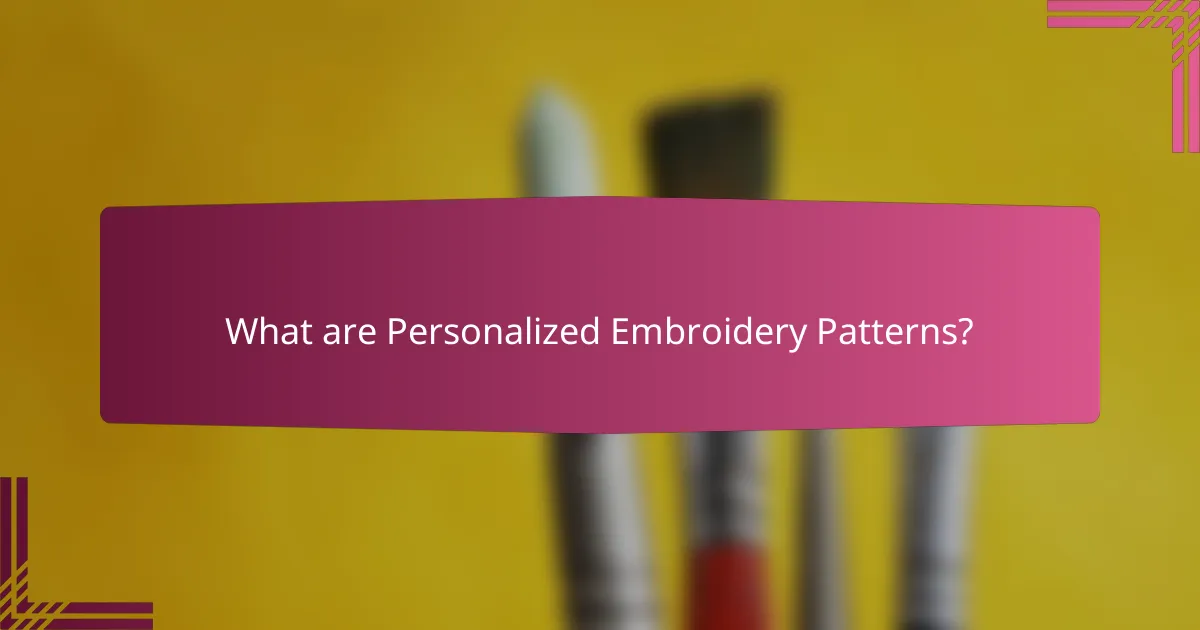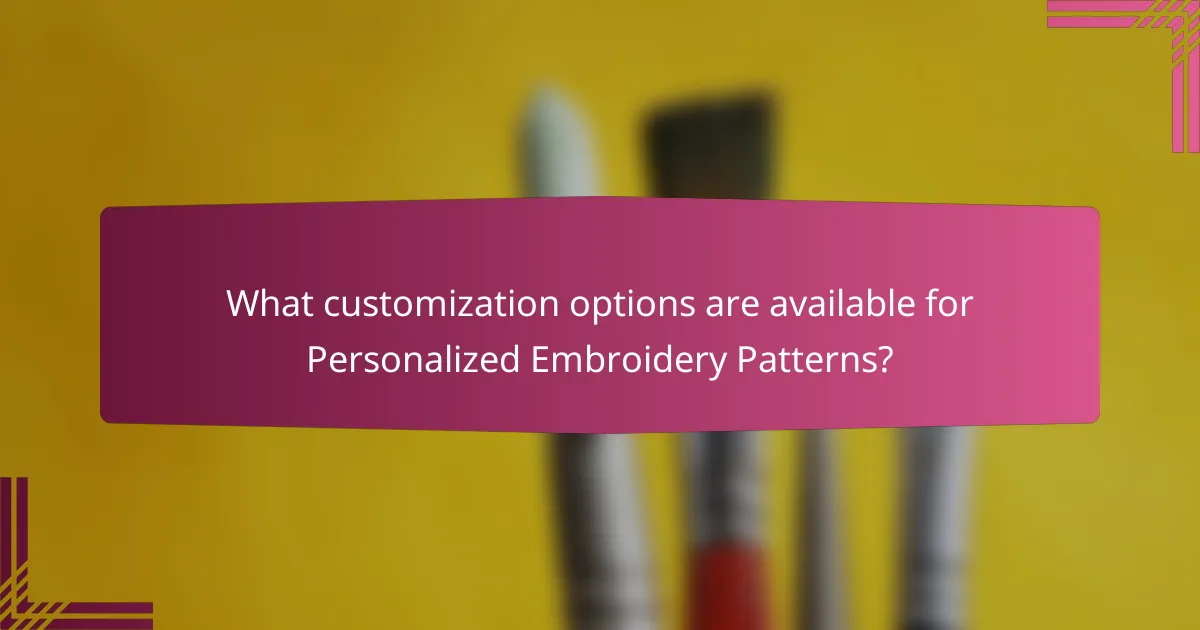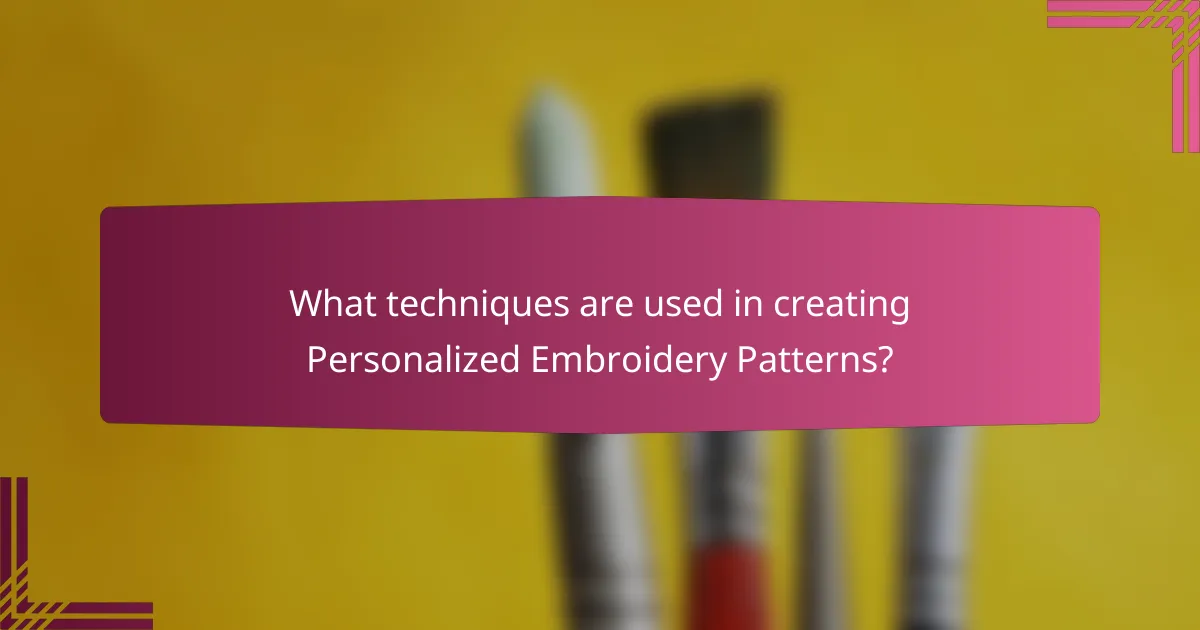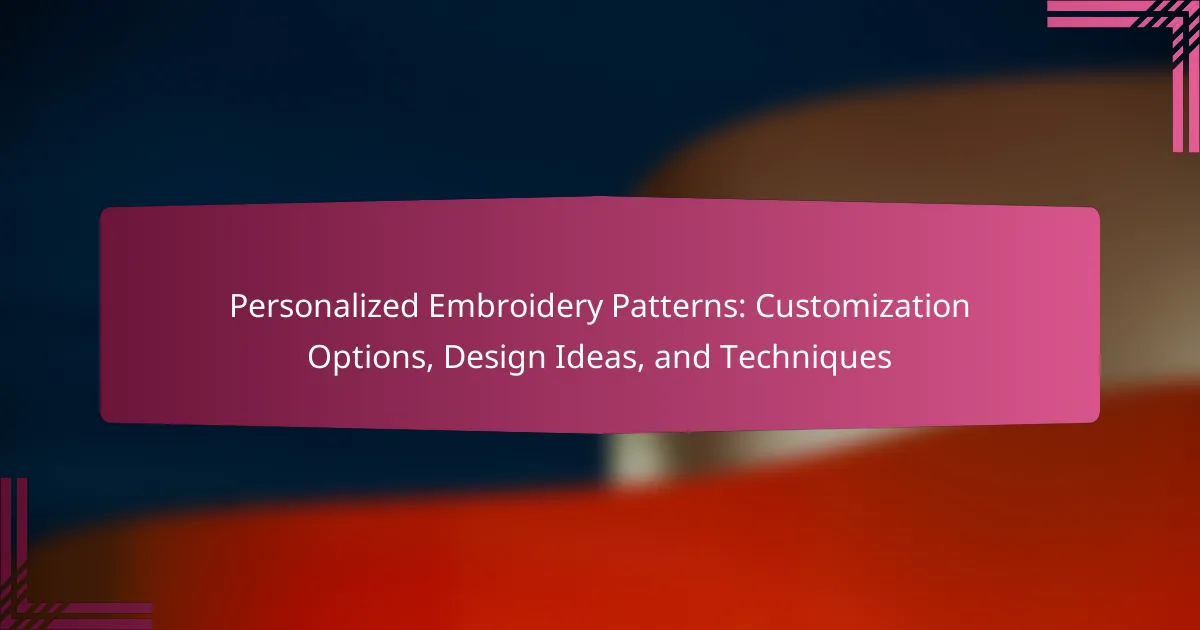
What are Personalized Embroidery Patterns?
Personalized embroidery patterns are unique designs created to reflect individual preferences or themes. They can incorporate names, dates, or specific motifs that hold personal significance. These patterns allow for customization in colors, styles, and sizes. Personalized embroidery is often used for gifts, home decor, or fashion items. The process involves digitizing a design for embroidery machines, ensuring precision in stitching. Many online platforms offer tools to create these patterns easily. Personalized embroidery patterns enhance the emotional value of items, making them special and memorable.
How do Personalized Embroidery Patterns differ from standard designs?
Personalized embroidery patterns differ from standard designs by allowing for unique customization tailored to individual preferences. Standard designs often follow set patterns and themes, lacking personal touches. Personalized patterns can include specific names, dates, or images meaningful to the individual. This level of customization enhances emotional connection and personal significance. Additionally, personalized patterns can be created to match specific color schemes or styles desired by the customer. In contrast, standard designs typically have limited options for modification. The ability to incorporate personal elements makes personalized embroidery patterns distinct and more valuable to the recipient.
What are the key characteristics of Personalized Embroidery Patterns?
Personalized embroidery patterns are unique designs tailored to individual preferences. They often feature custom text, images, or motifs that reflect personal significance. These patterns can be created using various techniques, such as machine embroidery or hand stitching. Color schemes are typically chosen based on the individual’s taste or the intended use of the item. The size and placement of the embroidery can also be adjusted to fit specific items, like clothing or home decor. High-quality materials are often selected to ensure durability and aesthetic appeal. Personalized embroidery patterns can serve as meaningful gifts or commemorative pieces, adding sentimental value.
How can personalization enhance the embroidery experience?
Personalization can significantly enhance the embroidery experience by allowing individuals to create unique designs that reflect their personal style. Customizing colors, patterns, and text makes the finished product more meaningful. It enables users to incorporate personal symbols or messages, making each piece one-of-a-kind. Research shows that personalized products often lead to higher customer satisfaction and emotional attachment. A study by the Journal of Consumer Research indicates that personalization increases perceived value and user engagement. By tailoring designs, embroidery becomes a form of self-expression. This approach can also foster a deeper connection between the creator and the final product. Overall, personalization transforms embroidery from a generic craft into a personalized art form.
What are the benefits of using Personalized Embroidery Patterns?
Personalized embroidery patterns provide unique customization for individual projects. They allow for personal expression and creativity in design. These patterns can be tailored to specific themes or occasions, enhancing the emotional value of the item. Personalized patterns can also be used for branding purposes, making items distinctive and recognizable. According to a survey by the Embroidery Trade Association, 75% of consumers prefer customized products over generic ones. This preference highlights the growing demand for personalized items in the market. Additionally, personalized embroidery can serve as thoughtful gifts, adding sentimental value to the recipient.
How do Personalized Embroidery Patterns contribute to unique gifts?
Personalized embroidery patterns create unique gifts by adding a custom touch that reflects the recipient’s personality. These patterns can incorporate names, dates, or specific designs meaningful to the individual. This level of personalization makes the gift more memorable and cherished. According to a survey by GiftAdvisor, 70% of recipients prefer personalized gifts over generic ones. Personalized embroidery patterns also demonstrate thoughtfulness and effort from the giver. This effort enhances emotional value, making the gift stand out. Additionally, unique designs can cater to specific interests or hobbies of the recipient, further increasing the gift’s significance.
What role do Personalized Embroidery Patterns play in branding?
Personalized embroidery patterns play a significant role in branding by creating a unique identity for businesses. These patterns enhance brand recognition through distinctive designs that resonate with target audiences. They allow companies to showcase their values and aesthetics visually. Personalized patterns foster emotional connections with customers, making the brand more relatable. Studies show that brands with unique visual elements can increase customer loyalty. For instance, a survey by the American Marketing Association found that 70% of consumers prefer brands that offer personalized products. This illustrates how personalized embroidery can differentiate a brand in a competitive market.

What customization options are available for Personalized Embroidery Patterns?
Personalized embroidery patterns offer various customization options. Users can select thread colors to match their preferences or themes. They can also choose different fabric types for the base of their embroidery. Size adjustments are possible, allowing for small or large designs. Custom text can be added, including names or special dates. Unique designs can be created from user-provided images or sketches. Patterns can also feature specific motifs or symbols that hold personal significance. Finally, there are options for finishing techniques, such as framing or creating patches. These choices enhance the personalization of each embroidery project.
How can colors and threads be customized in embroidery?
Colors and threads in embroidery can be customized by selecting specific shades and types of thread. Embroidery machines often allow users to choose from a wide range of thread colors. Additionally, designers can mix colors to create unique shades. Different thread materials, such as cotton or polyester, can also be selected based on the desired finish. Users can adjust color placements within the design software. This flexibility enables the creation of personalized patterns. Many embroidery threads come in various textures, which can enhance the overall look. Customization enhances the uniqueness of each embroidery project.
What are the best practices for choosing colors in personalized designs?
Best practices for choosing colors in personalized designs include understanding color theory, considering the target audience, and ensuring contrast for readability. Color theory provides a framework for selecting harmonious colors. The target audience influences color preferences and emotional responses. Contrast enhances visibility and makes designs more appealing. Additionally, using a limited color palette can create a cohesive look. Research shows that colors can evoke specific emotions, which can impact user engagement. For example, blue often conveys trust, while red can evoke excitement. These insights guide effective color selection in personalized designs.
How do different threads affect the final look of the embroidery?
Different threads significantly impact the final look of embroidery. The type of thread alters texture, sheen, and overall appearance. Cotton threads provide a matte finish, while polyester threads offer a glossy look. Metallic threads add sparkle and dimension to designs. Variegated threads create gradient effects, enhancing visual interest. Thread thickness influences stitch density and detail clarity. Thicker threads produce bolder designs, while finer threads allow for intricate patterns. The choice of thread color affects contrast and vibrancy in the embroidery. Each thread type contributes uniquely to the final aesthetic outcome.
What types of designs can be personalized?
Various types of designs can be personalized, including clothing, home decor, accessories, and gifts. Personalized clothing often includes t-shirts, jackets, and hats with custom embroidery. Home decor items like pillows, blankets, and wall art can also feature unique designs. Accessories such as bags, wallets, and jewelry can be customized with initials or specific motifs. Additionally, gifts like mugs, photo frames, and keychains offer personalization options. This versatility in design personalization caters to individual preferences and occasions.
What are popular themes for personalized embroidery patterns?
Popular themes for personalized embroidery patterns include floral designs, animals, and monograms. Floral designs often feature intricate patterns and vibrant colors. Animal motifs are favored for their playful and whimsical appeal. Monograms provide a personal touch, often incorporating initials or names. Other themes include nature scenes, quotes, and holiday-specific designs. These themes cater to various tastes and occasions, making them popular choices for customization.
How can names and initials be incorporated into designs?
Names and initials can be incorporated into designs through various techniques. Common methods include embroidery, printing, and engraving. Embroidery allows for intricate stitching of names or initials on fabric. Printing offers a smooth finish, suitable for various materials. Engraving provides a permanent option on harder surfaces like metal or wood.
Personalization enhances the uniqueness of items, making them special gifts or keepsakes. Incorporating names and initials can reflect personal identity or commemorate events. Studies show that personalized items often have higher emotional value for recipients. This trend in customization aligns with consumer preferences for unique and meaningful products.

What techniques are used in creating Personalized Embroidery Patterns?
Common techniques used in creating personalized embroidery patterns include digitizing, freehand embroidery, and appliqué. Digitizing converts images into embroidery files. This process involves using software to create a stitch map. Freehand embroidery allows for creative expression without a predefined pattern. It is often used for unique designs. Appliqué involves stitching fabric pieces onto a base fabric. This technique adds texture and dimension to the design. Other techniques include monogramming, which personalizes items with initials. Techniques like machine embroidery provide consistency and speed. Each method offers distinct advantages for customization.
How does digitization impact the embroidery process?
Digitization significantly enhances the embroidery process by streamlining design creation and production. It allows for precise and intricate designs that traditional methods cannot achieve. Digitized designs can be easily modified and customized to meet specific needs. This technology also reduces the time required for setup and production. Automated embroidery machines can read digitized files, improving efficiency. Furthermore, digitization facilitates the use of advanced software for design visualization. This leads to better planning and fewer errors during production. Overall, digitization transforms embroidery into a more efficient and creative process.
What software is commonly used for creating personalized patterns?
Adobe Illustrator is commonly used for creating personalized patterns. This software allows users to design intricate and customizable patterns effectively. It offers a wide range of tools for vector graphics, which are essential for pattern creation. CorelDRAW is another popular choice, known for its user-friendly interface and powerful design capabilities. Additionally, software like Ink/Stitch, which is specifically designed for embroidery, enables users to create and modify embroidery patterns directly. These programs are widely recognized in the design community for their versatility and functionality in pattern creation.
How can one ensure quality during the digitization process?
To ensure quality during the digitization process, one must follow a systematic approach. First, utilize high-resolution images as input. This enhances the clarity and detail of the final output. Second, select appropriate software that supports advanced features for embroidery digitization. This includes tools for adjusting stitch types and densities. Third, conduct thorough testing on sample fabrics before final production. This helps identify any issues with stitch placement or tension. Fourth, maintain consistent communication with the embroidery team throughout the process. This ensures alignment on design expectations and quality standards. Lastly, implement a review process to evaluate the final digitized patterns. This should include checks for accuracy and adherence to the original design. Following these steps can significantly improve the quality of digitized embroidery patterns.
What stitching techniques are best for personalized patterns?
The best stitching techniques for personalized patterns include satin stitch, applique, and free-motion embroidery. Satin stitch provides a smooth finish and is ideal for filling shapes. Applique allows for layering fabrics, adding texture and dimension to designs. Free-motion embroidery enables intricate, custom designs with a sewing machine. These techniques enhance personalization by allowing unique expressions in embroidery. For instance, satin stitch is commonly used in monograms, while applique can incorporate various fabrics for a personalized touch. Free-motion embroidery offers complete creative freedom, making it suitable for custom artwork.
What are the differences between hand embroidery and machine embroidery?
Hand embroidery and machine embroidery differ primarily in technique and execution. Hand embroidery involves stitching by hand using needles and thread. This method allows for greater artistic expression and customization. It often results in unique, intricate designs that reflect the embroiderer’s skill. Machine embroidery, on the other hand, utilizes a sewing machine or embroidery machine to create designs. This method is faster and more efficient for producing uniform patterns. Machine embroidery often allows for the use of digitized designs, which can be replicated easily. The choice between hand and machine embroidery depends on the desired outcome, time constraints, and personal preference.
How can various stitches enhance the personalization of patterns?
Various stitches can enhance the personalization of patterns by adding distinct textures and visual effects. Each stitch type, such as satin, chain, or cross-stitch, contributes uniquely to the overall design. For example, satin stitches create a smooth, shiny finish, while chain stitches offer a more textured appearance. This variety allows for creative expression and customization in embroidery projects. Additionally, different stitches can be used to highlight specific areas of a design, drawing attention to key elements. The choice of stitch can also reflect personal style, making the final piece more meaningful. Using a combination of stitches can further enhance the complexity and uniqueness of the pattern, allowing for endless customization possibilities.
What are the common challenges in creating Personalized Embroidery Patterns?
Common challenges in creating personalized embroidery patterns include design complexity and color matching. Designers often struggle with translating intricate ideas into stitchable formats. This can lead to patterns that are either too detailed or not detailed enough. Additionally, selecting the right thread colors to match the original design can be difficult. Variations in thread texture and sheen can affect the final appearance. Another challenge is ensuring proper sizing for different fabric types. Incorrect sizing can result in patterns that distort when stitched. Lastly, software limitations can hinder the ability to create custom designs efficiently. These factors can complicate the personalization process significantly.
How can one troubleshoot issues with thread tension?
To troubleshoot issues with thread tension, first, check the threading path of the machine. Ensure the thread is correctly seated in the tension discs. Next, adjust the tension dial to see if it improves the stitch quality. Test different thread types and sizes, as they can affect tension. Inspect the needle for damage or incorrect size, which can lead to tension problems. Finally, examine the bobbin case for proper installation and tension settings. Consistent tension issues often indicate a need for machine maintenance or cleaning.
What steps can be taken to avoid design distortions?
To avoid design distortions in personalized embroidery patterns, ensure accurate scaling of designs. Use vector graphics for clarity at any size. Maintain consistent thread tension during stitching to prevent puckering. Choose appropriate fabric types that match the design’s complexity. Test designs on similar fabric scraps before the final project. Adjust the design’s density based on the fabric’s characteristics. Utilize software tools to visualize the final outcome before stitching. These steps help maintain the integrity of the design throughout the embroidery process.
What tips can enhance the experience of creating Personalized Embroidery Patterns?
To enhance the experience of creating personalized embroidery patterns, start by selecting a meaningful design. Choose images or symbols that resonate personally. Utilize software tools for precise customization and visualization. Experiment with various thread colors to see how they affect the design. Test different fabric types for texture and appearance. Incorporate personal elements, like names or dates, to make the pattern unique. Seek inspiration from existing patterns or nature to spark creativity. Lastly, practice regularly to improve skills and gain confidence in design choices.
Personalized embroidery patterns are unique designs tailored to individual preferences, incorporating elements like names, dates, and motifs. This article explores the differences between personalized and standard designs, highlighting key characteristics, customization options, and techniques used in creating these patterns. Additionally, it discusses the benefits of personalized embroidery, including its role in gifting and branding, as well as best practices for color selection and stitching techniques. The content also addresses common challenges in the creation process and offers troubleshooting tips to enhance the overall embroidery experience.
